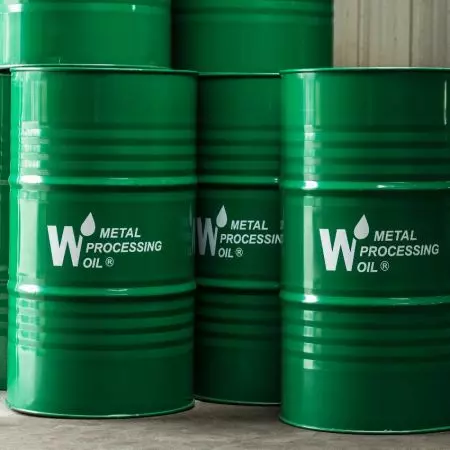
5 Critical Warning Signs of Hydraulic Oil Deterioration and How to Fix Them
Industrial lubricants - hydraulic oil AW32, AW46, AW68
In automated and industrial machinery, the hydraulic system is often regarded as the heart of the operation—and hydraulic oil (or hydraulic fluid) is the lifeblood that keeps it running smoothly. Unfortunately, many users overlook the condition of their hydraulic oil until system issues or machine failures arise. By then, the fluid may have already deteriorated, potentially causing serious damage to expensive equipment.
This article details the five most common signs indicating immediate hydraulic fluid degradation. Understanding these signals is the first step in effective preventative maintenance and ensuring long-term system efficiency
1. Darkened or Cloudy Oil: The Threat of Oxidation and Contamination
A quick visual inspection can reveal early signs of oil degradation. Fresh hydraulic oil typically appears clear or pale yellow.
■ Darkening (Tea-Brown to Black): This is a strong indicator of severe oxidation due to heat, or heavy contamination by metal particles, carbon residue, or foreign oil.
■ Cloudy or Milky Appearance: This frequently signals water ingress and emulsification. Water severely compromises the fluid's lubricating film strength, impacting pressure stability and leading to accelerated wear.
Fix: Schedule fluid analysis, check breathers and seals for leaks, and consider using dehydration equipment if water contamination is confirmed.
2. Foamy or Milky Surface Suggests Air or Water Ingress
Excessive foaming or a frothy, milky appearance on the surface of the hydraulic oil suggests that air or moisture has been drawn into the system. Common causes include poor reservoir sealing, low oil levels, or suction line leaks. Foaming is detrimental because it:
■ Reduces pressure stability and component cooling efficiency.
■ Accelerates oil oxidation (air introduction).
■ Causes cavitation damage to pumps.
Fix: Inspect the reservoir seal and suction lines for leaks. If oil is confirmed to be contaminated, utilize professional defoaming additives or specialized dehydration techniques.
3. Burnt or Sour Smell: A Sign of Thermal Degradation
A pungent, sour, or burnt odor emanating from the hydraulic system is a critical indicator of thermal breakdown and oxidation. This means the oil has been exposed to excessive heat, often caused by poor cooling efficiency, clogged radiators, or continuous high-load operations.
High heat causes the base oil and additives to degrade, generating acidic compounds and varnish. This not only reduces fluid performance but also corrodes internal components, seals, and pumps.
Fix: Immediately verify the performance of the cooling system. If operating temperatures remain high, consider upgrading to high-quality, high-temperature-resistant AW-rated hydraulic oils.
4. Abnormal Pressure Levels Indicate Viscosity Breakdown
■ Consistent drops in pressure output, sluggish actuator movement, or excessive heat can often be traced back to viscosity changes.
■ Viscosity Thinning: Caused by extreme temperatures or improper mixing, this compromises the protective oil film, leading to metal-to-metal contact and wear.
■ Viscosity Thickening: Caused by severe oxidation or cold environments, this increases resistance, resulting in pressure fluctuations and reduced efficiency.
Fix: Implement a regular viscosity testing schedule. Always ensure the correct ISO Viscosity Grade (VG32, VG46, or VG68) is used, matching the OEM specifications and operating environment.
5. Frequent Filter Clogging Signals Heavy Contamination
If your hydraulic filters are requiring replacement more often than usual, it signals an unacceptably high contamination level—either from excessive dirt ingress, or internal generation of sludge and varnish. These microscopic particles accumulate, causing:
■ Premature filter element failure.
■ Pressure fluctuations and flow restriction.
■ Accelerated wear on sensitive components like servo valves and pumps.
Fix: Replace filters, and most importantly, perform a system flush of the tank and lines. Introduce new, clean oil and implement stricter contamination control measures (e.g., better breathers or bypass filtration).
Customer Case: Emulsified Hydraulic Oil Shuts Down Production Line
At one of our client sites—a precision automotive parts manufacturer—the production line suddenly experienced erratic pressure and abnormal noise during operation. Upon inspection, the oil was found to be milky white with heavy foam, indicating severe emulsification. It was discovered that water had entered the system due to rainwater seeping through a poorly sealed tank cover. The lack of routine oil condition checks and delayed oil changes forced the plant to halt operations for two full days for system cleaning and refilling. The financial loss served as a powerful reminder of why proactive oil condition monitoring is essential for production uptime.
📞 Request a Free Consultation +886-25332210
Hydraulic systems demand the right oil — don’t leave performance to chance
Dealing with frequent breakdowns, overheating, or reduced equipment efficiency? The wrong hydraulic fluid could be the hidden cause. Our experts can help you select the ideal oil for your equipment type, operating conditions, and performance goals.
Fill out the form below to get expert advice tailored to your hydraulic system..
- Recommend Product
WILL Hydraulic Oil AW-32
High-Performance Anti-wear Oils ISO 32
WILL AW-32 Hydraulic Oil is a shear-stable and high-quality lubricant which is formulated with...
DetailsWILL Hydraulic Oil AW-46
High-Performance Anti-wear Oils ISO 46
WILL AW-46 Hydraulic Oil is a high quality lubricant manufactured from refined paraffin base...
DetailsWILL Hydraulic Oil AW-68
High-Performance Anti-wear Oils ISO 68
WILL Hydraulic Oil AW-68 is a top-tier industrial lubricant, specifically formulated to deliver...
Details- Articles
When selecting hydraulic oil, you’ll often come across three common anti-wear grades: AW32, AW46, and AW68. But what do these numbers mean, and how do you choose the best option for your machinery? Is a higher...
Read more

